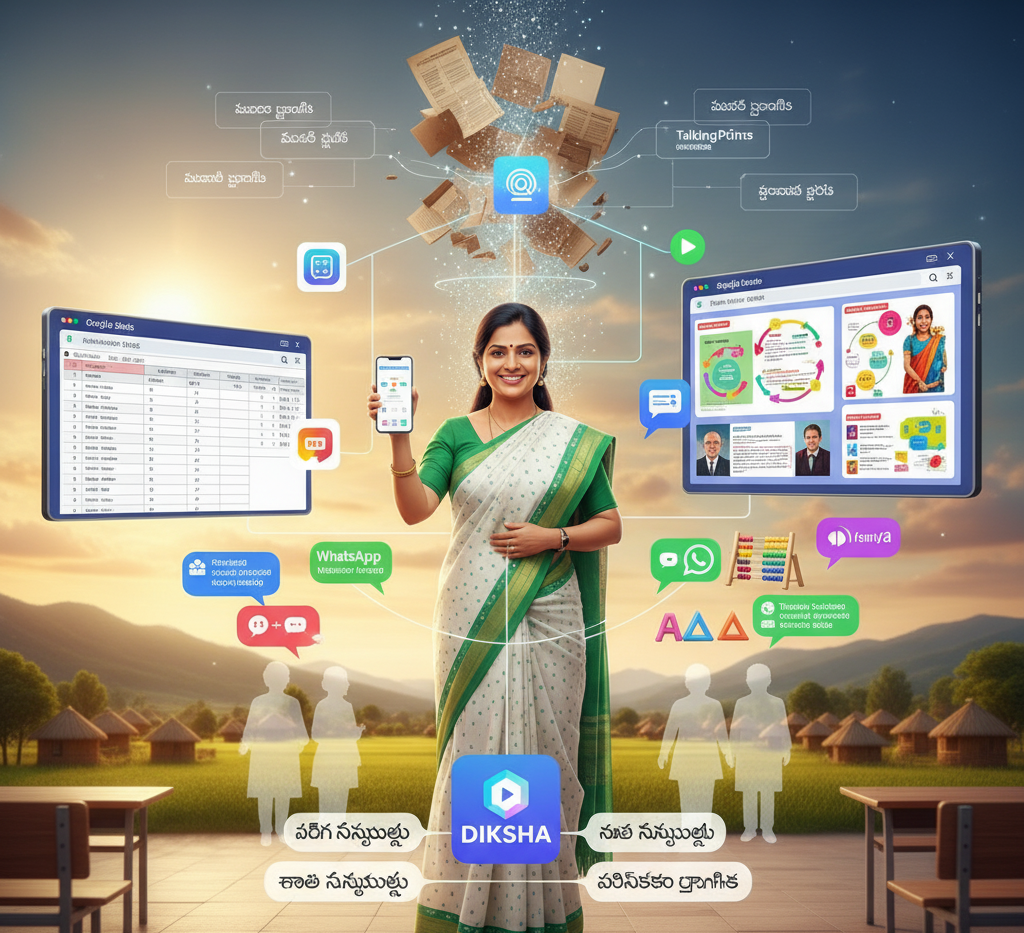
Keyword Focus: Indian Teacher Productivity, Simple EdTech for Government Schools, AI tools for marking, WhatsApp for parent follow-up, reducing teacher workload, non-techy teacher tips, work-life balance for Indian teachers.
Part I: The Silent Burden – When The Bell Isn’t The End
My name is Asha Devi, and for fifteen years, I have taught Mathematics and Environmental Science at a small government upper primary school in the heart of rural Maharashtra. Every single morning, as I cycle to school past the fields, I feel a surge of purpose. I am not just a teacher; I am a storyteller, a guide, a motivator. I am teaching the future.
Yet, every single afternoon, as the final bell rings, a wave of cold dread washes over me. That is when my second job begins—the job of the administrator, the clerk, and the data entry specialist. It’s the job that steals my light.
The Emotional Drain of Dual Lives
If you are a government teacher, you know this feeling intimately. You are dedicated to your students, but your evenings are consumed by tasks that bring no joy, only pressure and exhaustion.
- The Weight of the Register: That thick, heavy attendance book is the symbol of my burden. Every day, I spend twenty minutes manually marking, and at the end of the month, the nightmare begins: tallying every single ‘P’ and ‘A’ for forty students across twenty-five working days. The sheer drudgery often left me questioning my career choice. “Did I study for years just to do addition?” the tired voice in my head would ask. The stress of knowing a single mistake could lead to hours of corrections, or worse, administrative issues, was suffocating. This was not a data problem; it was an emotional accuracy problem.
- The Mountain of Marks: Unit tests, half-yearly exams, formative assessments… the papers piled up. I would grade them in dim lamplight, hunched over my kitchen table. Then came the marks posting into the main register—slow, painstaking, and filled with the fear of transposed numbers. Forget marks analysis! Finding the average, spotting the weakest concept, and designing a remedial plan of action felt impossible after midnight. My teaching became generalized, not targeted, because I simply ran out of time and energy to process the data effectively.
- The Unending Communication Loop: Then there were the absentee students phone follow-ups. Calling fifty parents, many of whom only speak the local dialect, often without a clear understanding of what I needed. And the writing minutes of meeting—handwritten, shared, and invariably lost. The paperwork was drowning the passion. The physical and mental workload was crippling my health.
This was my life. Until I realized I already held the keys to my freedom in my hand: my humble Android smartphone.
Part II: Asha’s Digital Revolution – Simple Apps, Big Impact
I am not an expert. My English is functional, and I often struggle with new technology. But what I discovered is that the most effective tools for us, the government teachers in interior regions, are not complicated; they are simple, free, and available in regional languages. They require minimal internet and maximum common sense.
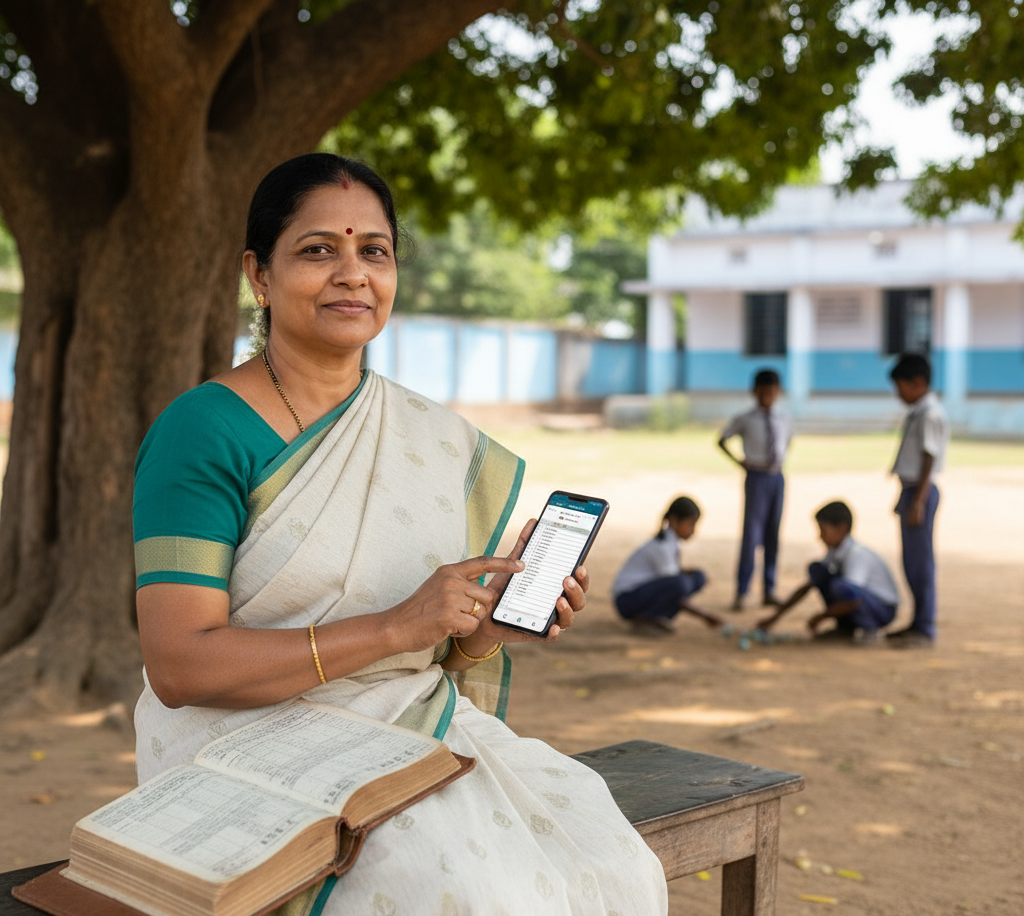
Here are the five simple steps—the Digital Diya—that started lighting up my work:
1. The Digital Register: Absolute Control with Google Sheets
I abandoned the heavy physical register and replaced it with Google Sheets on my mobile. This was the first major step to saving my sanity.
- The Problem It Solves: Manual tallying and calculation errors.
- The Humanistic Difference: No more hours spent with a pencil and calculator. I can update the sheet while sitting under the school tree during my tea break.
- The Action: I created a single sheet with student names. I input attendance daily. For the monthly summary, I use the simple, in-built
SUMfunction. The best part? It auto-saves. I never have to worry about a lost register again! - The Benefit Metrics: My time spent on attendance dropped by 80%. My accuracy became perfect. The physical pressure of carrying and maintaining the register disappeared.
2. Marks Posting & Remedial Focus: The Magic of Google Forms
I started giving objective (MCQ) unit tests via Google Forms. This solved two major problems: grading time and analysis time.
- The Problem It Solves: Manual grading and delayed, generalized remedial plans.
- The Humanistic Difference: I get instant data right after the test. I no longer have to wait days to know which concepts need re-teaching. I can teach while the topic is still fresh.
- The Action: I create the quiz in Hindi/Marathi on Forms. When students submit, Forms auto-grades and generates a summary chart. I immediately use Conditional Formatting in the resulting Google Sheet to highlight students who scored below 40%.
- The Benefit Metrics: Workload reduced drastically as the software did the grading. The instant marks analysis clearly flags my remedial group. This targeted teaching is what truly improves reading and writing skills because I know exactly where the learning gap is.
3. TLM, ABL, and Presentation Pride: The Canva Confidence
I used to be embarrassed by my hand-drawn charts. My TLM looked dull compared to private school resources. Now, I use the simplest app to create beautiful, professional material
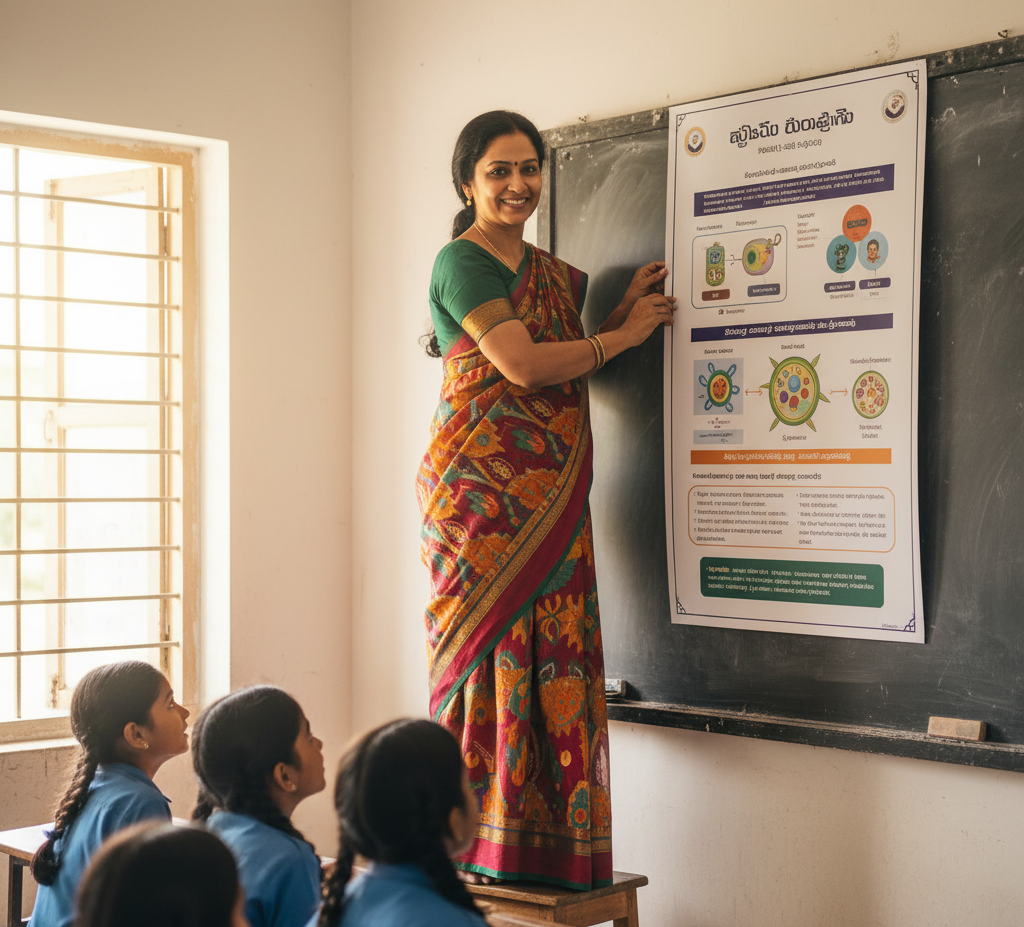
- The Problem It Solves: Low-quality TLM that takes too long to draw/decorate, impacting my professional pride.
- The Humanistic Difference: I feel proud walking into the classroom with a beautiful chart I created in minutes. It makes my ABL (Activity-Based Learning) preparation feel structured and effective.
- The Action: I use Canva for Education (free) on my phone. I search for a poster or flashcard template, type my text (in regional script), and use the free image library. I print it at a local copy shop.
- The Benefit Metrics: Creativity and professionalism skyrocketed. Time spent on TLM preparation dropped from hours to minutes. This ensures my presentation quality is high, keeping students engaged and improving comprehension.
4. The Parent Bridge: The Voice of WhatsApp & TalkingPoints
Parents messages and absentee follow-up were my most draining administrative duties. Many parents work in the fields all day and cannot read complicated texts.
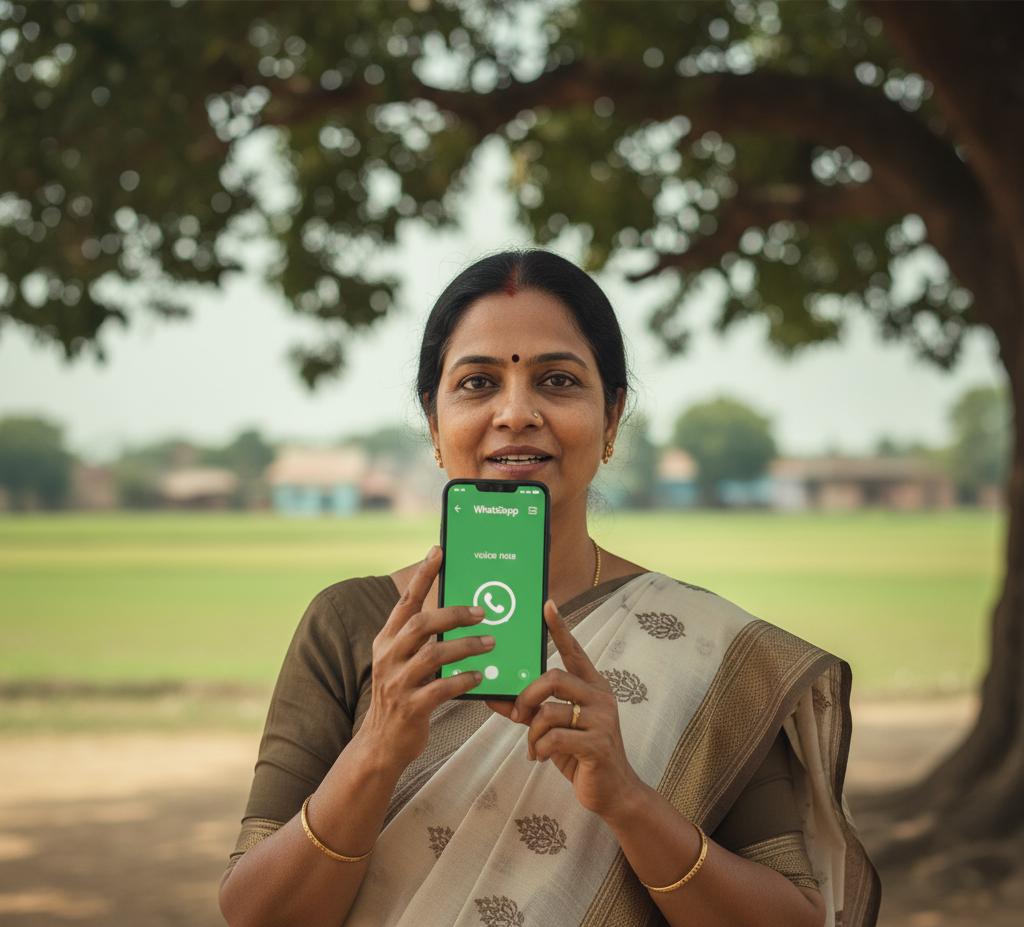
- The Problem It Solves: Ineffective, time-consuming parent contact and difficulty bridging language/literacy gaps.
- The Humanistic Difference: I connect with parents in a way that respects their time and literacy. They are no longer intimidated by the school system.
- The Action: I use WhatsApp Voice Notes for my class group. Instead of typing, I record a quick, warm 30-second message in our local dialect about homework or a child’s achievement. For absentees, one quick call is sufficient because the group ensures I am already sharing information proactively. For colleagues, we share Minutes of Meeting via a quick, typed message in a staff WhatsApp group, reducing the need for manual copy-pasting.
- The Benefit Metrics: Pressure from endless phone calls is eliminated. Workload related to individual parent contact dramatically reduced. The immediacy of the voice note improves our school-home connection, directly impacting student attendance and improvement of reading and writing skills through parental support.
5. The Master Planner: DIKSHA and Google Docs
A proper Year Plan and Monthly Plan were always tough to create from scratch, especially when government policy changes mid-year.
- The Problem It Solves: Static, difficult-to-edit planning documents and a shortage of verified local-language resources.
- The Simple Fix: DIKSHA (the official, multilingual platform) and Google Docs.
- The Action: I draft my master Year Plan once on Google Docs. When policy changes, I can edit the document easily, anywhere, even from the playground. I use DIKSHA to find verified, regional-language videos and lesson plans, directly aligning my ABL preparation with curriculum standards.
- The Benefit Metrics: Time spent on planning is minimized because I reuse and edit digital files instead of re-writing. Accuracy in curriculum alignment is guaranteed through DIKSHA.
Part III: The Magic of AI: A Non-Techy’s Secret Weapon
There is one small, final step I use, which feels like magic: when I absolutely must deal with a pile of old, handwritten data. This is where simple AI tools come in, even for a non-techy teacher like me.

If I receive a supervisor’s circular on paper or have an old, messy marksheet: I simply take a good photograph of the document. Then, I upload the image to a powerful but user-friendly AI like Google Gemini (or Microsoft Lens). My simple instruction is: “Please convert the text on this image into a simple list/table.”
Within seconds, the AI spits out the text, ready for me to copy and paste into my Google Sheet. This tiny trick saves me from retyping long lists of student names, dates, or marks. It’s the highest boost to accuracy and the fastest way to demolish administrative drudgery. This ability to instantly transform paperwork into digital data truly alleviates the feeling of being overwhelmed.
A Humanistic Interlude: Reclaiming My Soul
The truth is, these five tools have not only saved me hours of time and eliminated administrative pressure—they have fundamentally changed who I am outside the classroom.
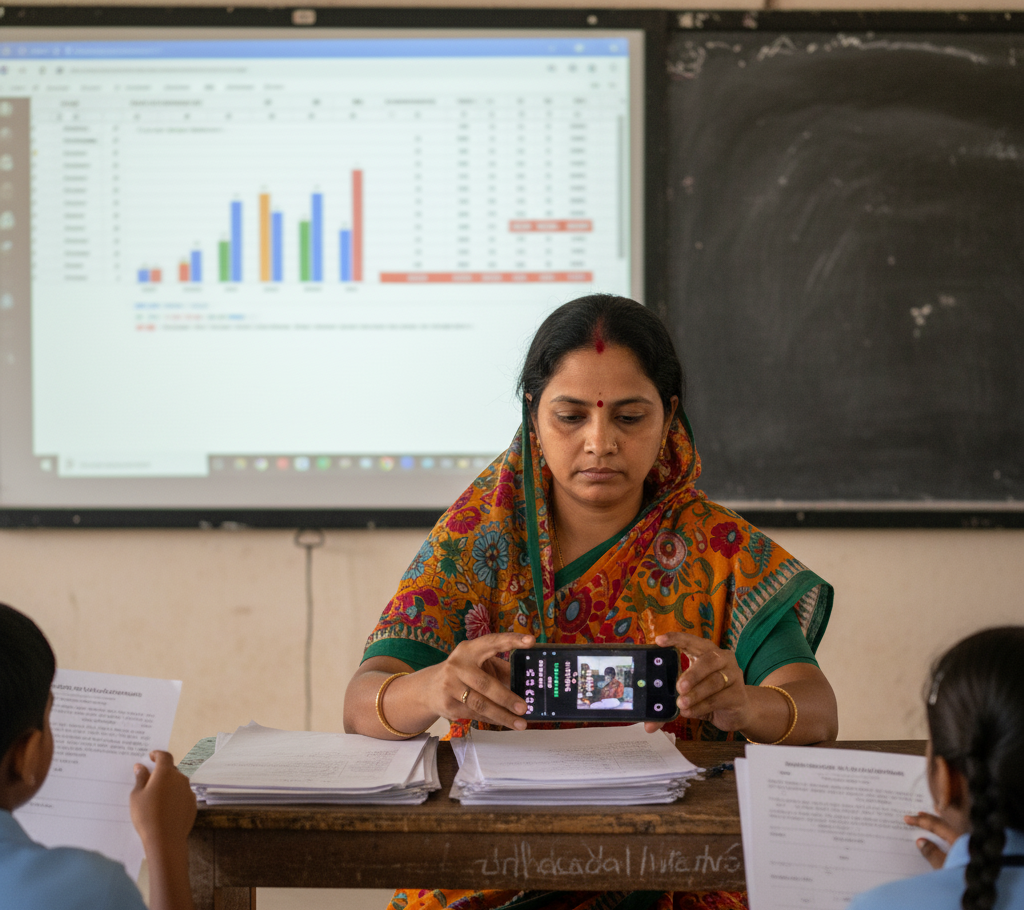
I now leave school with the satisfaction of a job well done, not the dread of work waiting at home. I spend my evenings reading a book, speaking with my family, or simply resting—which improves my health and allows me to return to the classroom the next day with genuine energy.
When my students see me energized, smiling, and ready to teach, they are more engaged. The real purpose of this EdTech revolution is not the app itself, but the human connection it allows us to rediscover. It lets the teacher in me thrive.
Part IV: Thought-Provoking FAQs for the Empowered Teacher
We often have deep, philosophical questions about technology in our classrooms. Here are ten things I thought about on my journey:
| FAQ | The Thought-Provoking Answer |
| 1. Is technology taking away my human connection with students? | A: Absolutely not. The time you save on marking 40 papers is the time you reclaim to sit next to the one student who is struggling, to listen to the child’s story, or to simply make eye contact and smile. The app handles the data; you handle the heart. |
| 2. My English is weak. How can I use these English-based apps effectively? | A: Focus on the features, not the language. Google Sheets functions are universal (SUM, AVERAGE). WhatsApp and DIKSHA work in your regional language. The best part of modern AI tools is their multilingual capability: you can often input your prompt in Hindi or your local dialect, and the tool will understand and assist. Your expertise is in teaching, not in technology language. |
| 3. What if I lose my phone, and all my data is gone? | A: This is why we use Cloud-Based Apps (like Google Sheets/Docs). Your data is not stored on your phone; it is stored on the internet (the “cloud”). If you lose your phone, you simply log in on a new device, and everything is instantly restored. This is safer than a paper register that can be lost or damaged in a flood or fire. |
| 4. Is this just creating another source of administrative surveillance? | A: While government schools face official reporting, these tools simplify the process you already have to do. Instead of spending hours preparing a physical report for your supervisor, you simply share a link to your Google Sheet. It makes your mandated work easier and transparent, saving you the personal effort. |
| 5. We have limited internet or network issues in my interior location. How can I use these apps? | A: Focus on Offline Features. Google Sheets and DIKSHA often allow you to access and edit files offline; they sync automatically the moment you connect to a network later in the day. The core tasks (attendance, planning) can be done with limited connectivity. |
| 6. My students’ parents don’t have smartphones. How is WhatsApp communication effective? | A: Even if only one parent in a nearby house has a phone, or if the child’s older sibling has one, that one point of contact is better than none. Use TalkingPoints—it can often translate and send messages as simple SMS to basic phones, closing the communication gap with the least literate families. |
| 7. How do I convince my older, non-techy colleagues to adopt these methods? | A: Don’t tell them, show them. Show them the joy of leaving work on time. Start with the simplest tool: a 2-minute demonstration of how ZipGrade grades a test. Success is contagious. Focus on the relief it provides, not the technology itself. |
| 8. Does using AI/Canva reduce my own creativity for TLM? | A: No. It acts as your design assistant. Instead of spending 90% of your time drawing and 10% on content, AI handles the drawing (the tedious part). You spend 90% of your time on what truly matters: curating the best content and designing the most impactful ABL activities. It frees your creativity, it doesn’t limit it. |
| 9. I feel guilty about using technology to save time. Shouldn’t I be spending more time on my students? | A: This is the most important thought. You are spending more time on your students. The time saved on clerical work is time repurposed for pedagogical work: lesson refinement, personalized feedback, mental preparation, and self-care. A rested, energetic teacher is the best resource a student can have. Your well-being directly translates to their success. |
| 10. What is the single biggest mindset shift I need to make to succeed with EdTech? | A: Stop seeing technology as an extra task. Start seeing it as free labor. It is an assistant that works tirelessly for you, for free. The moment you delegate the drudgery (data entry, calculation) to the app, you empower yourself to focus on the magic (teaching). |
Export to Sheets
Part V: The Promise of Tomorrow – A New Dawn
The challenges facing the Indian government teacher are unique, rooted in systemic issues of resource scarcity, high administrative demands, and often, isolation. But our strength lies in our adaptability, our resilience, and our deep commitment to the children who walk through our gates every day.
We are not just adopting technology; we are launching a revolution of self-care, efficiency, and professional pride. By embracing simple, accessible digital tools, we are saying, “My time is valuable. My energy is sacred. My focus must be on teaching, not typing.”
This journey is not about reaching a digital finish line; it’s about starting the race toward a more balanced, joyful, and effective career. Let us carry this Digital Diya forward, lighting the path for our students and, crucially, for ourselves. Let us retire the heavy registers, put away the smudged ledgers, and trade exhaustion for exhilaration.
The time we reclaim today is the future we spend teaching. This is not a dream. It is the simple, powerful reality waiting on your smartphone. Go ahead, close that register, and reclaim your time. The school bell has rung, but your life is just beginning. The best teacher is a rested teacher.

